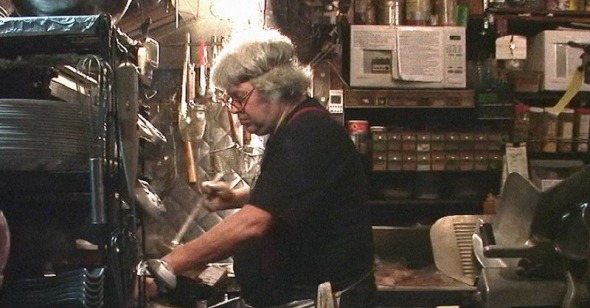Dressed to Grill
By Michael Koresky
I Like Killing Flies
Dir. Matt Mahurin, U.S., THINKFilm
Wisely, director/editor/cinematographer Matt Mahurin focuses much of his attention on the food in his laidback, downtown New York restaurant documentary I Like Killing Flies. The Manhattan-honed eccentricities of its protagonist and bona fide New York City “character” Kenny Shopsin aside, Mahurin’s film seems fitfully impressed by the astonishing array of meals and odd combos served at Shopsin’s. And even for anyone who lives in New York, let alone in some strip-mall and chain-restaurant-plagued Anywhere, Suburbia, the variety and apparent quality of proprietor Kenny Shopsin’s mix-and-match menu will elicit a small gasp. From one tiny, cramped kitchen in a modestly sized West Village neighborhood haunt, Kenny spews out seemingly incongruous ethnic cuisines, one after another, as well as endless varieties of comfort foods, spun out with wildly slapdash invention. For instance, pancakes infused with BBQ chicken or macaroni and cheese sit a mere table away from cashew chicken or a “Thai Cobb” salad. Jewish, Mexican, Chinese, Cuban, even Senegalese dishes spike the menu at Shopsin’s, even though the tangiest flavor, and what people come back for repeatedly, as the film alleges, is the candor, and occasional volatility, of Kenny himself. The choice is yours: did you come to Shopsin’s for the social commentary or the “Postmodern Pancakes” (cooked, then mashed up with batter, and put back on the griddle, FYI)?
Unfortunately, Mahurin’s aesthetic doesn’t quite capture the hominess and local color that have obviously made Shopsin’s an old standby for more than 32 years. Without any sort of spatial sense and without finding a visual means to break up the restaurant’s unavoidable claustrophobia, I Like Killing Flies, while notable for its very existence and an engaging testament to Kenny’s individuality, nevertheless does its subject a slight disservice. The raw, greasy aesthetic could be rationalized as appropriate for a place in which its very owner remarks that his oven “looks like a whore’s ass,” yet the digital video adds unnecessary layers of grime to an already modest establishment. The place simply looks dirty. Additionally, for a film so homegrown and urban-centric, there’s absolutely no feeling of placement; rarely has the colorful individuality of downtown New York come across as so anonymous. The lack of integrity to the image (there’s a jittery, slightly sped-up quality to the cheap video, and sometimes Mahurin sticks the camera’s tiny microphone in the frame, his fingers visible in the lower-left hand screen) bespeaks of a certain laziness that’s become the norm in indie documentary filmmaking.
That said, the sense of hurried tribute, of creating a last longing look on the fly does ultimately work in the film’s favor. Kenny Shopsin lost his lease, after so many years of serving the neighborhood’s denizens (as well as out-of-towners), and before packing up his beloved restaurant and moving to a new location in the West Village, he asked Mahurin, a regular customer with whom one can infer he would lovingly babble about art and politics for many years prior, to document the old Shopsin’s for posterity. What resulted was a feature-length video, brimming with enough foul charm and pontificating about the bourgeoisie to make it something of a festival favorite.
Identified many times by patrons as a final hold-out amidst the encroachment of gentrification, Shopsin’s has survived, even if its more expansive second location (and new website, natch) seems to have lost a little bit of the original’s cramped authenticity. What could never be lost, however, is Kenny’s iconoclastic spirit, manifest in his antiwar ravings and philosophies on the inherent unremarkability of man in between carving up roast beef and cracking eggs. Even if Mahurin overstates the case on film, desperate as he is to wring eccentricity out of every moment (a superfluous, bafflingly extended sequence showing him berating his son for not feeding a parking meter is more filling than an order of Kenny’s butter-fried catfish fingers), Kenny, eternally dressed in a black T-shirt, belly hanging over his belt, red suspenders, and a headband holding in a sweaty tousle of grey hair, remains his own man. After spending a swift 80 minutes with him, it’s impossible to envision him ever doing anything other than slinging hash, complaining about “bustin’ my fuckin’ hump,” and cursing out customers who would dare to bring parties of five or more. And as Mahurin’s film testifies, that’s a reassuring thing.
